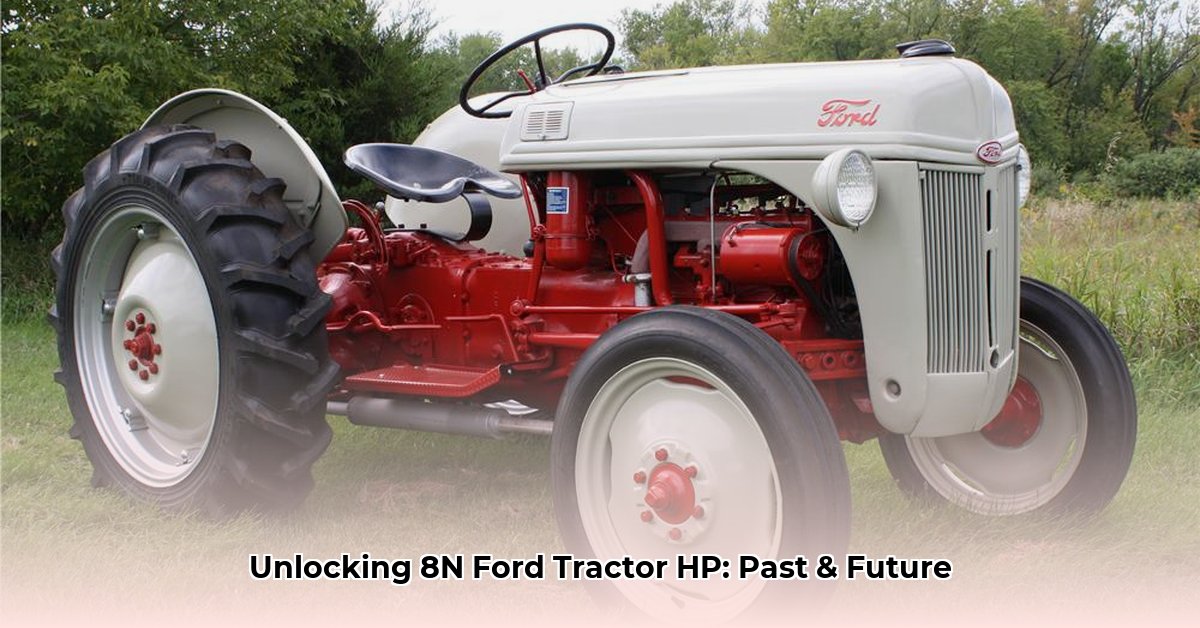
8N Ford Tractor HP: A Legacy of Power and Progress
The Ford 8N tractor, a symbol of mid-20th-century agricultural mechanization, continues to spark discussion regarding its impact on sustainable farming practices. While seemingly antiquated by today's standards, its legacy offers valuable insights into the complex relationship between technological advancement and environmental stewardship. This article examines the Ford 8N's horsepower, its historical impact, and strategies for mitigating its environmental footprint in modern sustainable agriculture. For a detailed comparison with the 9N model, see this helpful resource.
The 8N's Game-Changing Power
Before the widespread adoption of tractors, farming heavily relied on human and animal labor, limiting productivity and intensifying physical demands. The Ford 8N, boasting 18-25 horsepower depending on configuration, represented a significant leap in efficiency. This increase in power translated into drastically reduced labor hours, enabling farmers to cultivate larger land areas and produce greater yields. This boost in productivity played a crucial role in feeding a burgeoning global population. However, this technological advancement also led to significant societal shifts, including displacement of some farm laborers. How did this initial increase in efficiency impact the long-term sustainability of agricultural practices?
A Powerful Impact: Balancing Progress and Sustainability
The 8N's impact wasn't solely positive. Its internal combustion engine, reliant on either gasoline or diesel fuel, contributed significantly to greenhouse gas emissions – a concern largely overlooked during its era but paramount in contemporary sustainable agriculture. Compared to modern, fuel-efficient tractors, the 8N's environmental footprint was substantially larger. This underscores a critical lesson: technological progress often necessitates a careful evaluation of trade-offs, particularly concerning environmental sustainability.
Furthermore, the concentration of the 8N's weight on its rear wheels often led to soil compaction, impeding water absorption and root growth. This compaction, if not managed appropriately, could negatively affect soil health over extended periods. Modern tractors, equipped with advanced tire technology, are designed to mitigate this issue. The 8N's legacy serves as a poignant reminder that even seemingly minor design elements can have significant long-term ecological consequences. Did farmers of the time fully understand these potential long-term side effects?
Pioneering a Path to Modern Farming
Despite its drawbacks, the 8N's influence on agricultural technology is undeniable. Its robust design, relative ease of maintenance, and widespread accessibility fueled its popularity and spurred further innovation. The 8N's success laid the foundation for the development of higher-horsepower, fuel-efficient, and more environmentally conscious tractors currently in use. It stands as a pivotal milestone in the evolution toward more sustainable agricultural practices. What key lessons can contemporary farmers learn from the 8N's design and impact?
Comparing Past and Present: A Quantitative Analysis
A direct comparison between the Ford 8N and modern tractors vividly illustrates the advancements made in agricultural technology:
| Feature | 8N Ford Tractor | Modern Tractor |
|---|---|---|
| Horsepower (HP) | 18-25 hp | 50-500+ hp (wide range of models) |
| Fuel Efficiency | Relatively low | Significantly higher |
| Environmental Impact | Higher greenhouse gas emissions | Much lower greenhouse gas emissions (wide range) |
| Soil Compaction Potential | Higher | Lower (due to advancements in tire technology) |
| Technology | Basic mechanical systems | Sophisticated electronics, GPS guidance, etc. |
The contrast is striking. Modern tractors offer vastly superior horsepower, fuel efficiency, and reduced environmental impact, while incorporating advanced technology for precise farming operations.
Mitigating the 8N's Environmental Impact in Modern Sustainable Farms
The Ford 8N, while a symbol of agricultural innovation, poses challenges for modern sustainable farming practices due to its lower fuel efficiency and potential for soil compaction. How can we integrate this classic tractor into contemporary sustainable agricultural systems?
Understanding the 8N’s Environmental Footprint
The 8N's environmental impact primarily stems from its fuel consumption and soil compaction potential. Its relatively low horsepower necessitates longer operating times for the same task, leading to increased fuel usage and higher greenhouse gas emissions. The tractor's weight can compact soil, reducing water infiltration and hindering root growth.
Practical Mitigation Strategies
Successfully integrating the Ford 8N into modern sustainable farming requires a multi-faceted approach:
Optimize Fuel Efficiency: Precision farming techniques, such as careful field planning to minimize unnecessary travel, can significantly reduce fuel consumption. Regular maintenance, including engine tuning and tire pressure checks, further enhances efficiency.
Reduce Soil Compaction: Utilizing wider tires or low-ground-pressure tires minimizes soil compaction. Adopting alternative tillage methods, such as no-till farming, and implementing crop rotation and cover cropping improve soil health and reduce the long-term effects of compaction.
Implement Best Practices: Where compatible with engine specifications, using sustainable fuel sources like biodiesel blends can reduce reliance on fossil fuels. Meticulous fluid management prevents leaks and minimizes environmental contamination.
Strategic Technology Integration: For larger operations, combining the 8N with smaller, more fuel-efficient tractors for specialized tasks leverages the 8N's strengths while mitigating its environmental drawbacks.
Carbon Sequestration: Prioritizing soil health practices, such as cover cropping and no-till farming, enhances carbon sequestration, partially offsetting emissions from the 8N's use.
The 8N's Role in a Sustainable Future
The Ford 8N is not inherently incompatible with sustainable farming. By acknowledging its limitations and implementing appropriate mitigation strategies, its use can be responsibly integrated into modern agricultural systems. It becomes a testament to resource optimization and the importance of thoughtful, intentional farming practices.
Key Takeaways:
- The Ford 8N's lower fuel efficiency and potential for soil compaction pose challenges to sustainable farming.
- Mitigation strategies include optimizing fuel use through precision farming and maintenance.
- Reducing soil compaction involves using specialized tires and implementing soil health practices.
- Sustainable fuel options (where engine compatible) and responsible fluid management are vital.
- Integrating the 8N with modern technology enables a balanced approach, balancing its usefulness with environmental concerns.
- Efficient farming practices and soil health initiatives are crucial in mitigating the overall impact.